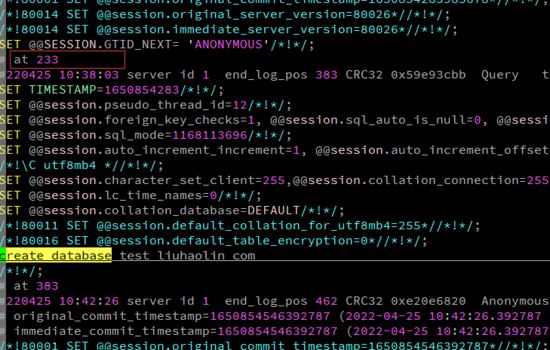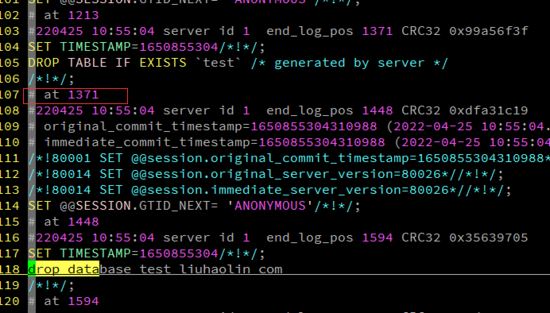How to use mysql binlog to restore data
Before using mysql binlog for data recovery, binlog must be enabled first. Set up a test environment here to learn how to use mysql binlog to restore the database. The principle is relatively simple. Binlog will store changed data in mysql. For example, if you create a database and write some data, these will be stored in the binlog of mysql.
When you need to restore, you need to find two positions: a starting position and an ending position. Half of the ending position is the position before the data was destroyed or deleted. Mysql 8 has binlog enabled by default
mysql> show variables like '%log_bin%'; +---------------------------------+--------------------------+ | Variable_name | Value | +---------------------------------+--------------------------+ | log_bin | ON | | log_bin_basename | /data/mysql/binlog | | log_bin_index | /data/mysql/binlog.index | | log_bin_trust_function_creators | OFF | | log_bin_use_v1_row_events | OFF | | sql_log_bin | ON | +---------------------------------+--------------------------+
You can see that log_bin has been enabled. At the same time, you can see that the storage location is in the /daba/mysql directory. The prefix is binlog
ls /data/mysql/binlog.* /data/mysql/binlog.000143 /data/mysql/binlog.000144 /data/mysql/binlog.000145 /data/mysql/binlog.000146 /data/mysql/binlog.index
You can see that there are several A binlog log file, because this is the test database (there is historical information, previous data is useless), in order to facilitate testing, the reset operation is performed directly. Be careful when deleting all binlog files. If it is a production environment, the value of the data is immeasurable.
show master logs; +---------------+-----------+-----------+ | Log_name | File_size | Encrypted | +---------------+-----------+-----------+ | binlog.000143 | 156 | No | | binlog.000144 | 200 | No | | binlog.000145 | 156 | No | | binlog.000146 | 156 | No | +---------------+-----------+-----------+ 4 rows in set (0.01 sec) mysql> reset master; Query OK, 0 rows affected (0.02 sec) mysql> show master logs; +---------------+-----------+-----------+ | Log_name | File_size | Encrypted | +---------------+-----------+-----------+ | binlog.000001 | 156 | No | +---------------+-----------+-----------+ 1 row in set (0.00 sec) ls /data/mysql/binlog.* /data/mysql/binlog.000001 /data/mysql/binlog.index
After executing the reset (reset master), you can see that the previous binlog file has been deleted and a new binlog file is generated.
You can check the contents of this file
$mysqlbinlog binlog.000001 # The proper term is pseudo_replica_mode, but we use this compatibility alias # to make the statement usable on server versions 8.0.24 and older. /*!50530 SET @@SESSION.PSEUDO_SLAVE_MODE=1*/; /*!50003 SET @OLD_COMPLETION_TYPE=@@COMPLETION_TYPE,COMPLETION_TYPE=0*/; DELIMITER /*!*/; ...
At this time, we add some data
mysql <<EOT create database test_liuhaolin_com; select now(); EOT mysql <<EOT use test_liuhaolin_com; create table if not exists test( \`id\` int unsigned not null auto_increment primary key, \`key\` varchar(100), \`val\` varchar(255) ) engine=myisam charset=utf8mb4; EOT mysql <<EOT use test_liuhaolin_com; insert into test values ('1','website', 'https://www.liuhaolin.com'); EOT
At this time, we accidentally deleted the database test_liuhaolin_com
mysql> drop database test_liuhaolin_com; Query OK, 1 row affected (0.09 sec)
Now we need to solve a practical problem, how to restore this database
First of all, in order to prevent interference, execute flush logs to generate a new binlog file.
mysql> show master logs; +---------------+-----------+-----------+ | Log_name | File_size | Encrypted | +---------------+-----------+-----------+ | binlog.000001 | 1594 | No | +---------------+-----------+-----------+ 1 row in set (0.00 sec) mysql> show master status; +---------------+----------+--------------+------------------+-------------------+ | File | Position | Binlog_Do_DB | Binlog_Ignore_DB | Executed_Gtid_Set | +---------------+----------+--------------+------------------+-------------------+ | binlog.000001 | 1594 | | | | +---------------+----------+--------------+------------------+-------------------+ 1 row in set (0.00 sec) mysql> flush logs; Query OK, 0 rows affected (0.08 sec) mysql> show master status; +---------------+----------+--------------+------------------+-------------------+ | File | Position | Binlog_Do_DB | Binlog_Ignore_DB | Executed_Gtid_Set | +---------------+----------+--------------+------------------+-------------------+ | binlog.000002 | 156 | | | | +---------------+----------+--------------+------------------+-------------------+ 1 row in set (0.00 sec)
To recover data, you must first find where the data was deleted.
mysqlbinlog binlog.000001 | grep -n "drop database" 113:drop database test_liuhaolin_com
You can see that there is a delete statement at line 113. Finally, you can find two places
The starting position of the data that needs to be restored
The ending position of the data that needs to be restored
The starting position here is where the database is created, and the ending position is where the database is deleted.
mysqlbinlog --set-charset=utf8 binlog.000001 > tmp.sql
You can know the starting and ending positions in the file tmp.sql

binlog
You can see that the starting position is 233

binlog
You can see that the end position is 1371, so perform data recovery.
mysqlbinlog -v binlog.000001 --start-position=233 --stop-position=1371 | mysql
As a verification, you can check whether the database exists before execution.
mysql> use test_liuhaolin_com; ERROR 1049 (42000): Unknown database 'test_liuhaolin_com' # 执行恢复操作 mysqlbinlog -v binlog.000001 --start-position=233 --stop-position=1371 | mysql # 再次检查,可以发现数据已经恢复 mysql> mysql> use test_liuhaolin_com; Database changed
The above is the detailed content of How to use mysql binlog to restore data. For more information, please follow other related articles on the PHP Chinese website!

Hot AI Tools

Undresser.AI Undress
AI-powered app for creating realistic nude photos

AI Clothes Remover
Online AI tool for removing clothes from photos.

Undress AI Tool
Undress images for free

Clothoff.io
AI clothes remover

Video Face Swap
Swap faces in any video effortlessly with our completely free AI face swap tool!

Hot Article

Hot Tools

Notepad++7.3.1
Easy-to-use and free code editor

SublimeText3 Chinese version
Chinese version, very easy to use

Zend Studio 13.0.1
Powerful PHP integrated development environment

Dreamweaver CS6
Visual web development tools

SublimeText3 Mac version
God-level code editing software (SublimeText3)

Hot Topics
 1386
1386
 52
52
 MySQL: Simple Concepts for Easy Learning
Apr 10, 2025 am 09:29 AM
MySQL: Simple Concepts for Easy Learning
Apr 10, 2025 am 09:29 AM
MySQL is an open source relational database management system. 1) Create database and tables: Use the CREATEDATABASE and CREATETABLE commands. 2) Basic operations: INSERT, UPDATE, DELETE and SELECT. 3) Advanced operations: JOIN, subquery and transaction processing. 4) Debugging skills: Check syntax, data type and permissions. 5) Optimization suggestions: Use indexes, avoid SELECT* and use transactions.
 How to open phpmyadmin
Apr 10, 2025 pm 10:51 PM
How to open phpmyadmin
Apr 10, 2025 pm 10:51 PM
You can open phpMyAdmin through the following steps: 1. Log in to the website control panel; 2. Find and click the phpMyAdmin icon; 3. Enter MySQL credentials; 4. Click "Login".
 MySQL: An Introduction to the World's Most Popular Database
Apr 12, 2025 am 12:18 AM
MySQL: An Introduction to the World's Most Popular Database
Apr 12, 2025 am 12:18 AM
MySQL is an open source relational database management system, mainly used to store and retrieve data quickly and reliably. Its working principle includes client requests, query resolution, execution of queries and return results. Examples of usage include creating tables, inserting and querying data, and advanced features such as JOIN operations. Common errors involve SQL syntax, data types, and permissions, and optimization suggestions include the use of indexes, optimized queries, and partitioning of tables.
 How to use single threaded redis
Apr 10, 2025 pm 07:12 PM
How to use single threaded redis
Apr 10, 2025 pm 07:12 PM
Redis uses a single threaded architecture to provide high performance, simplicity, and consistency. It utilizes I/O multiplexing, event loops, non-blocking I/O, and shared memory to improve concurrency, but with limitations of concurrency limitations, single point of failure, and unsuitable for write-intensive workloads.
 Why Use MySQL? Benefits and Advantages
Apr 12, 2025 am 12:17 AM
Why Use MySQL? Benefits and Advantages
Apr 12, 2025 am 12:17 AM
MySQL is chosen for its performance, reliability, ease of use, and community support. 1.MySQL provides efficient data storage and retrieval functions, supporting multiple data types and advanced query operations. 2. Adopt client-server architecture and multiple storage engines to support transaction and query optimization. 3. Easy to use, supports a variety of operating systems and programming languages. 4. Have strong community support and provide rich resources and solutions.
 MySQL's Place: Databases and Programming
Apr 13, 2025 am 12:18 AM
MySQL's Place: Databases and Programming
Apr 13, 2025 am 12:18 AM
MySQL's position in databases and programming is very important. It is an open source relational database management system that is widely used in various application scenarios. 1) MySQL provides efficient data storage, organization and retrieval functions, supporting Web, mobile and enterprise-level systems. 2) It uses a client-server architecture, supports multiple storage engines and index optimization. 3) Basic usages include creating tables and inserting data, and advanced usages involve multi-table JOINs and complex queries. 4) Frequently asked questions such as SQL syntax errors and performance issues can be debugged through the EXPLAIN command and slow query log. 5) Performance optimization methods include rational use of indexes, optimized query and use of caches. Best practices include using transactions and PreparedStatemen
 MySQL and SQL: Essential Skills for Developers
Apr 10, 2025 am 09:30 AM
MySQL and SQL: Essential Skills for Developers
Apr 10, 2025 am 09:30 AM
MySQL and SQL are essential skills for developers. 1.MySQL is an open source relational database management system, and SQL is the standard language used to manage and operate databases. 2.MySQL supports multiple storage engines through efficient data storage and retrieval functions, and SQL completes complex data operations through simple statements. 3. Examples of usage include basic queries and advanced queries, such as filtering and sorting by condition. 4. Common errors include syntax errors and performance issues, which can be optimized by checking SQL statements and using EXPLAIN commands. 5. Performance optimization techniques include using indexes, avoiding full table scanning, optimizing JOIN operations and improving code readability.
 Monitor Redis Droplet with Redis Exporter Service
Apr 10, 2025 pm 01:36 PM
Monitor Redis Droplet with Redis Exporter Service
Apr 10, 2025 pm 01:36 PM
Effective monitoring of Redis databases is critical to maintaining optimal performance, identifying potential bottlenecks, and ensuring overall system reliability. Redis Exporter Service is a powerful utility designed to monitor Redis databases using Prometheus. This tutorial will guide you through the complete setup and configuration of Redis Exporter Service, ensuring you seamlessly build monitoring solutions. By studying this tutorial, you will achieve fully operational monitoring settings




